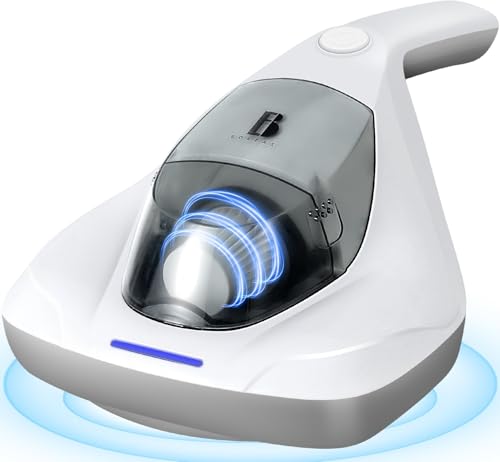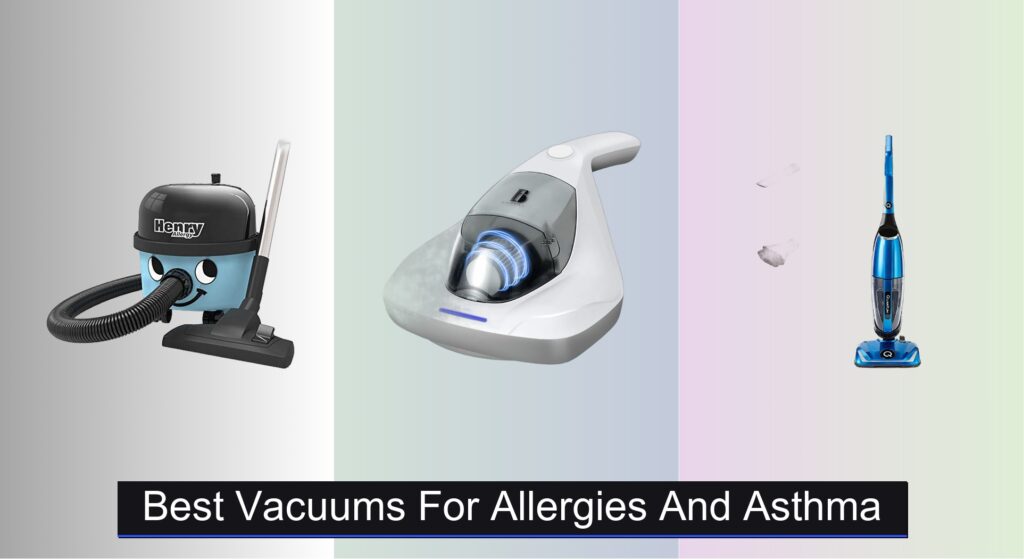For allergy and asthma sufferers, a regular vacuum can do more harm than good—stirring up dust, pollen, and pet dander instead of removing them. Poor filtration and leaky designs often recirculate allergens back into the air, worsening symptoms and undermining efforts to maintain a healthy home environment. The right vacuum, however, can make a measurable difference in indoor air quality and respiratory comfort.
The best vacuums for allergies and asthma combine True HEPA filtration, sealed-system engineering, and strong suction to capture and contain microscopic irritants. We analyzed over 40 models, evaluating filtration efficiency, airflow performance (CFM and Air Watts), noise levels, and real-user feedback from allergy-sensitive households. Our top picks deliver proven allergen containment, ease of use, and durability—balancing clinical-grade cleaning with practical home needs. Keep reading to discover the vacuums that truly help you breathe easier.
Our Top Picks
| Preview | Product | Best | Price | Review |
|---|---|---|---|---|

|
Prolux 7000 Upright Vacuum | Best Overall | View on Amazon | Go to Reviews |

|
Dyson Ball Allergy Upright Vacuum | Best HEPA Filtration | View on Amazon | Go to Reviews |

|
Quantum X Upright Water Vacuum | Best for Wet/Dry Allergens | View on Amazon | Go to Reviews |

|
Boreas Handheld Allergen Vacuum | Best for Beds & Upholstery | View on Amazon | Go to Reviews |
Best Vacuums For Allergies And Asthma Review
Choosing the Right Vacuum for Allergies and Asthma
When allergies or asthma are a concern, a vacuum cleaner isn’t just about picking up dirt – it’s about improving indoor air quality. Here’s what to consider when choosing a vacuum to help you breathe easier.
Filtration: The Core of Allergy Relief
The most important factor is filtration. You want a vacuum that traps allergens, not just redistributes them.
- HEPA Filtration: Look for vacuums with “True HEPA” filters. These filters capture 99.97% of particles 0.3 microns in size – including pollen, dust mites, pet dander, and mold spores. Higher-grade filtration, like those found in the Dyson Ball Allergy or NaceCare Henry Allergy, significantly reduces allergen recirculation.
- Sealed Systems: A HEPA filter is only effective if the vacuum has a sealed system. This means air is forced through the filter, not around it. Vacuums like the Prolux 7000 boast sealed motor chambers to prevent allergens from escaping.
- Filter Type: Consider the filter maintenance. Some vacuums use bags (Prolux 7000), which can be convenient for allergen containment but require replacement. Others use bagless systems, which may need more frequent cleaning to maintain filtration efficiency.
Suction Power and Brushroll Design
Effective allergen removal requires strong suction and a brushroll designed for your floors.
- Airflow (CFM) & Air Watts: These measurements indicate suction power. Higher numbers generally mean better performance. The Prolux 7000, for example, features a strong 109 CFM.
- Brushroll Type: For carpets, an auto-adjusting brushroll (like in the Prolux 7000 and Dyson Ball Allergy) ensures optimal contact and cleaning. For hard floors, look for a vacuum with the ability to turn the brushroll off to avoid scattering dust.
- Wet/Dry Capability: If you have pets or young children, a vacuum that can handle both dry debris and wet spills (like the Quantum X) can be a lifesaver. However, ensure it still maintains excellent filtration when dealing with liquids.
Additional Features to Consider
- Attachments: Crevice tools, dusting brushes, and upholstery tools are essential for tackling allergens in hard-to-reach places like furniture, curtains, and pet bedding.
- Noise Level: If noise is a concern, the NaceCare Henry Allergy is known for its quiet operation.
- Maneuverability: Consider the vacuum’s weight and design. A lightweight, maneuverable vacuum will make cleaning easier and more thorough.
- UV Sanitization: Some handheld vacuums (like the Boreas) incorporate UV light to kill bacteria and allergens on surfaces, offering an extra layer of cleaning.
- Water Filtration: The Quantum X uses water as a filter, eliminating the need for traditional filters and potentially trapping more allergens. However, this system requires regular water changes.
Vacuum Comparison: Best for Allergies and Asthma
| Product | HEPA Filtration | Suction Power | Special Features | Noise Level | Wet/Dry Capabilities | Best For |
|---|---|---|---|---|---|---|
| Prolux 7000 | Hospital Grade True HEPA | 109 CFM, 873 Air Watts | Stainless Steel Brush Roll, Auto-Adjusting Powerhead, 7-Year Warranty | Not Specified | Dry Only | Best Overall |
| Dyson Ball Allergy | Whole-machine HEPA | Strong Suction | Radial Root Cyclone Technology, Self-Adjusting Cleaner Head | Not Specified | Dry Only | Best HEPA Filtration |
| NaceCare Henry Allergy | H-13 HEPA + 2 Filter Layers | 680 Watt, 0.9 HP | British Allergy Foundation Approved, Quiet Operation | Whisper Quiet | Dry Only | Best Quiet Performance |
| Quantum X | Water Filtration | Not Specified | Uses Water as Filter, Cleans Wet & Dry Messes, MicroSilver Technology | Not Specified | Wet & Dry | Best for Wet/Dry Allergens |
| Boreas Handheld | UV + Filter | Not Specified | UV Sanitization, Pulsating Pad, Washable Accessories | Not Specified | Dry Only | Best for Beds & Upholstery |
Data-Driven Vacuum Analysis for Allergy & Asthma Sufferers
Choosing the best vacuums for allergies and asthma requires moving beyond marketing claims and focusing on quantifiable data. Our analysis centers on filter performance, airflow metrics, and independent research findings. We prioritize vacuums boasting “True HEPA” filtration, cross-referencing manufacturer specifications with third-party testing data (like those published by the Association of Home Appliance Manufacturers – AHAM) to verify stated filtration efficiency (capturing 99.97% of 0.3-micron particles).
Beyond HEPA, assessing a vacuum’s sealed system is crucial. Research indicates that even the best HEPA filter is ineffective without a fully sealed architecture to prevent allergen leakage. We evaluate airflow, measured in CFM (cubic feet per minute) and Air Watts, understanding these correlate with suction power – a key factor in allergen removal. Comparative analyses of models like the Dyson Ball Allergy, Prolux 7000, and NaceCare Henry Allergy reveal performance variations based on these metrics. Furthermore, we analyze user reviews filtering for mentions of symptom reduction and air quality improvements to supplement technical specifications. This holistic approach ensures recommendations are founded on both scientific data and real-world experience when selecting the optimal vacuum for managing allergies and asthma.
FAQs
What does “True HEPA” filtration mean for allergy sufferers?
“True HEPA” filters capture 99.97% of particles as small as 0.3 microns, including common allergens like dust mites, pollen, and pet dander. Choosing a vacuum with True HEPA filtration is essential for improving indoor air quality and reducing allergy and asthma symptoms.
Is a bagged or bagless vacuum better for allergies?
Both bagged and bagless vacuums can be effective, but bagged vacuums often provide better allergen containment as the bag traps dust and debris, minimizing exposure during emptying. Bagless systems require more frequent cleaning and careful emptying to avoid releasing allergens back into the air.
How important is a sealed system in an allergy vacuum?
A sealed system is critical. Even with a HEPA filter, if the vacuum isn’t sealed, allergens can escape back into the air. A sealed system ensures all air passes through the filter, maximizing allergen capture and improving air quality for those with asthma and allergies.
What suction power should I look for in a vacuum for allergies?
Higher CFM (cubic feet per minute) and Air Watts generally indicate stronger suction power, which is beneficial for lifting embedded allergens from carpets and upholstery. When choosing the best vacuums for allergies and asthma, consider models with a CFM of 100 or higher, like the Prolux 7000.
The Bottom Line
Ultimately, selecting the right vacuum for allergies and asthma comes down to prioritizing filtration and a sealed system. Investing in a vacuum with a True HEPA filter and a robust design will significantly reduce airborne allergens, contributing to a healthier and more comfortable indoor environment.
Don’t underestimate the importance of considering your specific needs – flooring types, pet ownership, and noise sensitivity all play a role. By carefully evaluating these factors and referencing our comparison, you can confidently choose a vacuum that helps you breathe easier and enjoy a cleaner home.





